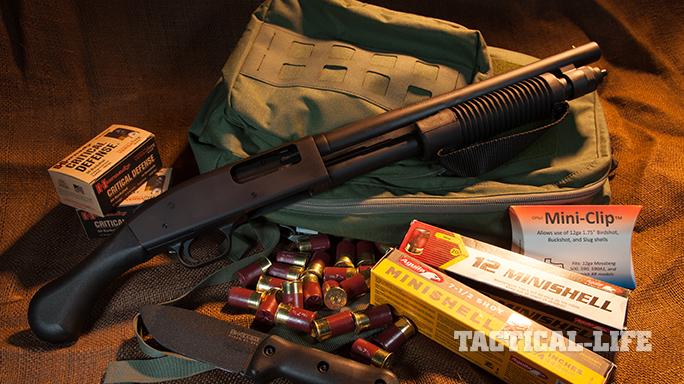Short-barreled shotguns look serious and intimidating. They’re handy in tight spaces and pack a punch well above their weight class in most cases. Traditionally, they’ve also been National Firearms Act (NFA) regulated items that require a $200 tax stamp, all of the associated paperwork and wait times of six months or longer, depending on how quickly the Bureau of Alcohol, Tobacco, Firearms & Explosives (BATFE) can process requests. So, while a stubby scattergun is appealing to many shooters for defense work, their appeal is somewhat limited due to the additional cost and paperwork that has always gone along with them. But what if you could legally get a similar class of weapon without all of the extra cost and paperwork? Then you’d have the new Mossberg Shockwave.
Defying Labels
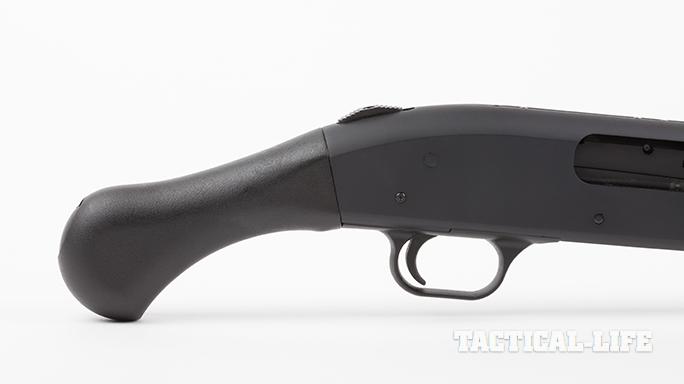
When I wandered up to the Mossberg shooting line during Industry Day at the 2017 SHOT Show, I was greeted by three stubby, pistol-gripped shotguns. I first thought it was neat to see Mossberg jumping into the factory short-barreled shotgun (SBS) and “any other weapon” (AOW) game. But as it turned out, I was only partially correct. There were indeed two AOWs there—the 590 and 500 Compact Cruisers—with pistol grips and 10.25- and 7.5-inch barrels respectively, but the third gun had a 14-inch barrel and sported a Shockwave Raptor bird’s-head grip.
Advertisement — Continue Reading Below
I made a comment about the trio of NFA guns and was politely corrected and informed that the Shockwave was simply a “firearm,” not an AOW or an SBS. Then, I quickly realized what I was looking at. I had actually talked to a Mossberg rep last year about building a gun like this. A couple of smaller companies have dipped their toes into the “firearm” category, but none of the major players in the gun industry had at that point. At the time, they weren’t ready to jump in to the market—or provide a writer the parts to build one on his own and write it up—but I must not have been the only one asking about it, because a year later, here we are.
So what is a “firearm” in NFA jargon, and how does it fit into the scheme of things? The BATFE defines a shotgun as “a firearm designed to be fired from the shoulder and designed to use the energy of the explosive in a fixed shotgun shell to fire through a smoothbore either a number of projectiles or a single projectile for each pull of the trigger.” A shotgun with a barrel or barrels less than 18 inches in length is considered an SBS and subject to a $200 tax as well as all of the regulatory paperwork that goes along with that. A “weapon made from a shotgun” is a shotgun-type weapon that has an overall length of less than 26 inches or a barrel or barrels less than 18 inches in length. That also is subject to the same $200 tax and paperwork.
Then we have the AOW category. An AOW is a weapon or device capable of being concealed on the person from which a shot can be discharged through the energy of an explosive. Included in this definition are pistols and revolvers having smoothbore barrels designed or redesigned to fire a fixed shotgun shell. This basically includes factory-made guns that were never intended to be shoulder fired, under 26 inches in overall length, with smoothbore barrels. An AOW is subject to a $5 tax and the same paperwork as the other NFA firearms. Confused yet?
Advertisement — Continue Reading Below
So, all of the aforementioned firearms are all regulated under the NFA. But the Mossberg Shockwave isn’t any of those—it’s considered a “firearm.” The difference between it and the aforementioned classes is its overall length and the fact that it’s a factory-built gun in that configuration. Although the barrel length of the Shockwave is 14 inches in length, the gun was manufactured with a pistol grip, so it was never intended to be shoulder fired, and it’s over 26 inches long, which puts it into a category not subject to any NFA requirements. It can be bought over the counter on a Form 4473 by anyone 18 years of age or older barring any state laws that might be more restrictive.
Still confused? Just roll with it. It’s a neat class of weaponry that has only really been explored by a few smaller companies, but I expect we’ll see more now that a player like Mossberg has jumped into the arena.
Mossberg Shockwave Details
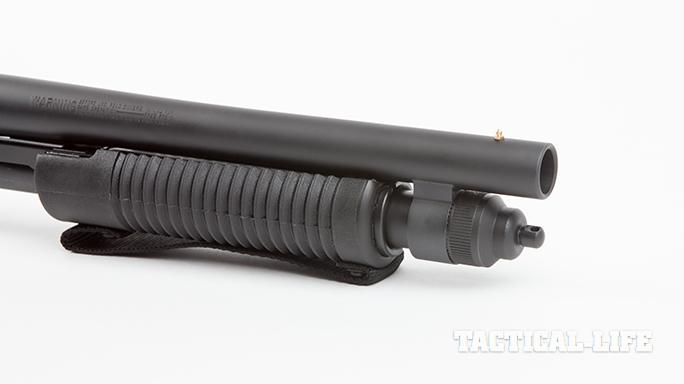
Advertisement — Continue Reading Below
The Mossberg Shockwave is built on the company’s time-tested and military- approved 590 receiver, and it’s fitted with a 14-inch, heavy-walled, cylinder-bore barrel with a bead sight. The aluminum receiver is drilled and tapped for optics, although, honestly, I’m not sure how well those would work on a gun like this. It features twin action bars and a ribbed, polymer forend with a hand strap to keep your support hand away from the stubby muzzle during recoil. An ambidextrous top-mounted safety makes the gun lefty friendly, and dual extractors and an anti-jam elevator ensure reliability.
As mentioned, the gun uses a Shockwave Raptor bird’s-head grip like those used on the old U.S. Marshals Service Witness Protection shotguns. The Raptor grip is the key to the Shockwave’s overall length of 26.37 inches. That length allows for the 14-inch barrel. Any shorter and you’d be looking at an NFA item.
My test gun only featured a sling swivel stud at the end of the magazine tube. However, production models will have one at the base of the grip as well. The magazine holds five 2¾-inch, 12-gauge shells, plus one in the chamber. The gun also weighs 5.25 pounds unloaded, which is 2 pounds lighter than an 18.5-inch-barreled 590 with a full stock. Finally, the MSRP on the Shockwave is only $455; that’s pretty reasonable considering you won’t have to deal with a $200 tax stamp.
Advertisement — Continue Reading Below
How It Shoots
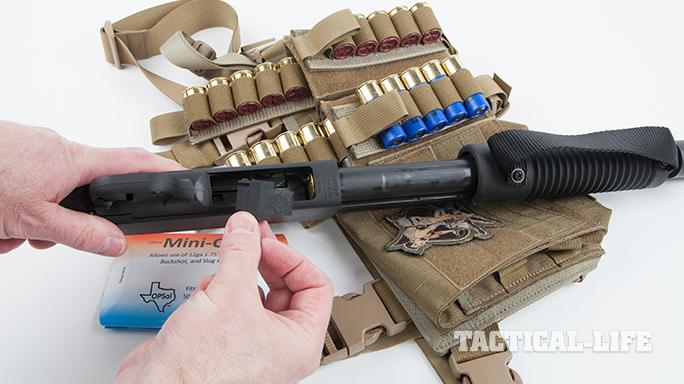
You might ask what it’s like to shoot a 14-inch-barreled 12 gauge with a pistol grip. The answer? It depends. At the SHOT Show, Mossberg was running Aguila Mini-shells through the gun, and it was actually quite pleasant to shoot. The recoil was mild, and follow-up shots were fast. When I needed ammo for my test sample, I reached out to Aguila. I got a quantity of the company’s buckshot, slug and #7½ field loads. I also got my hands on Hornady’s eight-pellet Critical Defense buckshot and 1-ounce American Gunner reduced-recoil slugs. The gun has a 3-inch chamber, but honestly, I had no desire to see what a 3-inch shell would feel like out of a 5.25-pound, pistol-grip shotgun.
At the range, I started with the Aguila Minishells. To aid in loading and feeding, I used a nifty gadget that I saw the Mossberg folks using at Industry Day: The OPSol Mini-Clip. This is a plastic spacer that snaps into the loading port of a Mossberg 500 or 590. It takes up enough space to keep the short Aguila Minishells from rattling around or flipping on the elevator to ensure smooth feeding. It takes only a few seconds to install, and the gun ran flawlessly with it in place. When I tried Minishells in my full-sized 590A1 a few years ago, I had some reliability issues due to the short length of the shells. OPSol seems to have solved this issue with a simple, clever device.
Advertisement — Continue Reading Below
The 1¾-inch Minishells have significantly less recoil than a standard 2¾-inch, 12-gauge shell. However, they still pack a hefty punch, particularly in the buck and slug loads. Aside from reduced recoil, the short shells also give you increased capacity. Rather than the normal 5+1 capacity, you can get 8+1 Minishells. The recoil with the Minishells was downright pleasant; I think just about anyone can handle this ammo without issue.
Moving up to the Hornady loads, the recoil increased significantly, even though these are reduced-recoil tactical loads. We use similar loads in my police department’s 14-inch-barreled Remington 870s. They’re pretty easy shooting with a buttstock, but you definitely know they’re going off with just the Shockwave Raptor grip. With that said, they’re by no means uncontrollable, especially with the hand strap on the forend.
Technique has a lot to do with recoil management, too. I basically found two ways to realistically shoot the Shockwave. One is the basic hip-shooting position with the butt of the Raptor grip tucked in along the hipbone. This method seemed to have the best recoil compensation but sacrificed accuracy—if you can call it that—since you’re truly just pointing the muzzle at the target and shooting. The other method is to bring the gun up into a high tuck, with the grip pulled into and alongside your ribcage. This translates a bit more recoil to your body, but the higher placement makes for more accurate shooting downrange.
Advertisement — Continue Reading Below
I did try shooting the gun from eye level, but I have a few words of caution. First, the Raptor grip places your hand at an odd angle when shooting at eye level. At least I found it a bit awkward. Second, without the gun braced against your body, you’re sacrificing recoil control. You do obviously gain the ability to use the bead sight, however, and aim more precisely. With the Minishells, it’s an option, although it’s still a bit awkward. With the Hornady loads, the recoil from that position was brisk. I managed to hit myself in the lip under recoil once. I didn’t do a lot of shooting from that position. If you’re going to practice this style of shooting, I’d recommend starting with a light target load until you get your technique down.
With all of that said, the Shockwave is a close-range gun. You aren’t going to be shooting clays with it or using it for 3-Gun matches. It’s for up-close-and-personal use in your house or around your vehicle. And for those situations, shooting from the hip or tucked in high works surprisingly well with the right loads. I did most of my shooting at 21 feet and a little at 45 feet as well. For comparison, most of the rooms and hallways in my house are around 12 to 14 feet across. The bigger rooms are around 20 feet across. About the longest shot I could get inside was around 40 feet going from my den, through the entry hall, and across the living room. The bottom line: For a house gun, 21 feet is a pretty reasonable test range. Meanwhile, 45 feet is “long range” for this gun.
Loading & Firing
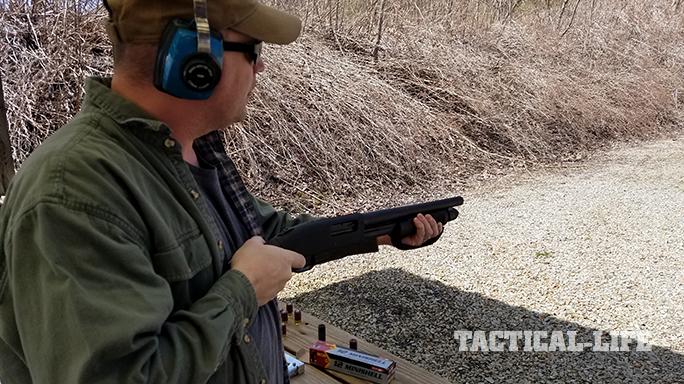
Advertisement — Continue Reading Below
When I hit the range, I had two of my buddies along. We found that although the basic pretense of pointing and shooting with the Shockwave is easy, there is a bit of a learning curve to doing it well. First off, we found that we tended to point high from both the hip and high-tuck positions. We had to adjust our hold to a bit to get good center-mass hits. The Hornady Critical Defense loads kept an extremely tight pattern, basically making one ragged hole at 21 feet; so it was definitely possible to miss if you weren’t doing your part. Which somewhat busts the myth that all you need to do is point a shotgun in the general direction of the target.
With that in mind, I think load selection is more critical with the Mossberg Shockwave than a fully stocked gun. The Shockwave fed everything we stuffed in it, including slugs. However, I don’t think they’re a great choice for this gun. Due to the technique that you need to shoot the gun, I think it’s beneficial to have some spread to make sure you’re getting hits on target. The 11-pellet Aguila buckshot load worked very well. It made palm-sized patterns at 21 feet and opening up to about hand-sized groups at 45 feet. Again, the Hornady loads made a ragged hole, maybe 1.2 to 2 inches wide at 21 feet. It also opened up to palm-sized groups at 45 feet.
Shock & Awe
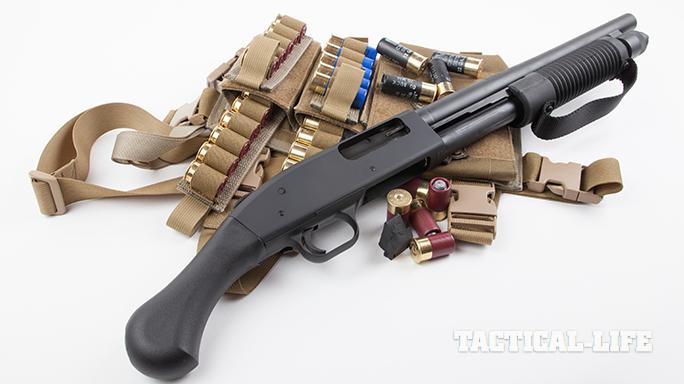
Advertisement — Continue Reading Below
The Mossberg Shockwave definitely has a wow factor to it—and a definite appeal for folks who always wanted an SBS but never wanted to jump through the hoops to get one. I expect Mossberg will sell tons of these based upon that alone, and they are fun guns to shoot. But I wouldn’t dismiss the utility of a short, easily maneuverable shotgun for use inside the home or workplace, or in and around vehicles. Even in this day and age of semi-auto rifles and carbines, the 12-gauge shotgun still holds its own as a fight-stopper. And Mossberg just made it a whole lot easier to bring one to the fight. For even more info, visit mossberg.com.
Mossberg Shockwave Specs
Gauge: 12; 3-inch chamber
Barrel: 14 inches
Overall Length: 26.37 inches
Weight: 5.25 pounds (empty)
Grip: Polymer
Sights: Front bead
Action: Pump
Finish: Matte black
Capacity: 5+1 (2¾-inch shells)
MSRP: $455
This article is from the August/September 2017 issue in “Tactical Weapons” Magazine. To order and subscribe, visit outdoorgroupstore.com.
